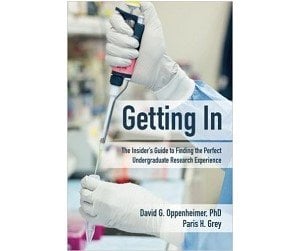Last Updated on June 26, 2022 by Laura Turner
Undergraduate students do not need told, again, how important it is to be involved in numerous activities: academics, extracurriculars, employment, research, job shadowing, internships, and social life. Students who are pursuing a career in a science or healthcare field (particularly those with aspirations for graduate school) may find even more intense pressure than their peers. This pressure – to check a box in each “category” above and to succeed at all of them – can be quite overwhelming, especially for students who don’t have any experience in one area or another. One of the most common areas with which students struggle is research. Many prehealth students understand that research should be part of their application, but do not know how to get started, or even what “research experience” means. If this sounds like you, check out Getting In: The Undergraduate’s Guide to Research Experience by David Oppenheimer and Paris Grey.
 Getting In is a short book that gets right to the point: many undergraduate students want to do research for one reason or another, but may not know much about it or how to get a position. The language is straightforward, the print is large, and the tone is aimed directly at undergraduate students; it’s clear from the beginning that the authors are highly attuned to the college student’s mindset and lifestyle. One of the book’s major credits is its readability – in fact, the first chapter lays out the structure, which includes bolding the most important points for those short on time. Each chapter has a clear title which guides the reader through the book, covering each topic briefly but thoroughly. Readers could easily skip the parts that are not relevant but still find useful information concerning their topics of interest.
Getting In is a short book that gets right to the point: many undergraduate students want to do research for one reason or another, but may not know much about it or how to get a position. The language is straightforward, the print is large, and the tone is aimed directly at undergraduate students; it’s clear from the beginning that the authors are highly attuned to the college student’s mindset and lifestyle. One of the book’s major credits is its readability – in fact, the first chapter lays out the structure, which includes bolding the most important points for those short on time. Each chapter has a clear title which guides the reader through the book, covering each topic briefly but thoroughly. Readers could easily skip the parts that are not relevant but still find useful information concerning their topics of interest.
I was struck, as I read, by how practical the book was. At no point did I feel the writing was esoteric or unnecessary – there is no “fluff” in this book. Instead, the authors begin by describing what “research” is, the different kinds of experiences, why anyone would want to do research, what you can gain from doing research – and then launch into the process of finding a position, beginning with searching for positions all the way through applying and interviewing. In almost every chapter, there are concrete examples which give the reader a clear understanding of what is being discussed. Further, much of their advice would be highly generalizable for any undergraduate or graduate student, specifically advice about professionalism, communication in emails, behavior in interviews, and etiquette for working in an academic environment.
Initially, I wondered if this book would convince someone who didn’t already want to do research that they should do it. I do think it was focused more for students who know they want to or “have to” do research but have little idea how to begin, but even so I found several chapters to give compelling reasons why a student would pursue research. They list many of the benefits of research and the skills developed, which double as excellent descriptors on a CV résumé, or talking points in an interview about research, beyond the generic phrases typically used.
One specific aspect I want to highlight, which the authors covered very well, was the search strategy for finding a position (chapter 6). This is probably the focus of the book for many students, who may have a grasp of what research is and what benefits it can provide, but are struggling to find a place to get involved. The practical tips offered include attending symposiums and conferences to learn about projects, then approaching the presenters with a brief pitch; asking TAs how they got involved and then approaching a professor; crafting an email that can be easily duplicated and sent to several potential labs; finding posters on display in the science building and contacting the “lowest-ranking” author first, asking to get involved; and searching on the web. This last point is where students often start, but is of course frequently futile; I remember applying for a few summer research fellowships this way as an undergraduate, but I’m sure my application was one of hundreds primarily because these programs were featured on search engines. The authors of Getting In don’t really comment on the difficulty of finding a position this way, but they do give helpful search engine terms to use, and they emphasize the other methods of finding a position over searching the internet, which I think is good advice.
As is probably clear from the above examples, the book overall has a very specific target audience. The authors cover bench research thoroughly, but there is little mention of clinical or field research, which may appeal more to many pre-medical students. Also, the authors seem to be operating under the assumption that readers are attending a research institution; there are many pieces about talking to TAs, approaching professors who do research, and finding projects at one’s institution which are probably very useful to these students but may not apply to all students. Perhaps I was more attuned to this simply because I didn’t attend a research institution for undergraduate, but I do wonder if more could be said about finding a project or lab to be involved with if you aren’t at a school that already does a lot of research. Either way, I don’t think this is much of a criticism; the book has a clear focus and handles that focus extremely well, so the students who need it will be able to benefit.
In searching for a project, the authors write about focusing more on the concept of the research rather than the day to day tasks; they recommend asking “whether the science inspires you” rather than, for example, will I be washing dishes, labeling jars, etc. I really like this, but I wish the authors had talked more about this topic. Many students consider the idea of research in the abstract, only as a hoop to be jumped through or point on a résumé for career benefits. In the day-to-day work of a lab, however, the question of whether the science inspires you does matter more – both for being committed to the project but also for being able to explain the research. As an example, consider how differently someone could explain a project that really intrigued them – “we’re trying to find out this one specific gene changes over time, and what effect that has on the human body” – versus someone with no interest or even understanding of the overall project, “basically I just put the gels in the machine and press a button all day.” I haven’t done much research personally, but I’ve realized as I’ve gotten further in my education that “research” in the abstract is not as interesting as the tangible: “I have a question that I’m curious about, but I’d like to find the answer.” This approach might be idealistic, especially for a freshman or sophomore undergraduate, but I would have liked to read more about it. Again, though, the book is a practical guide for getting in to a lab in a research position, so the authors probably felt that it wasn’t warranted.
I would definitely recommend this book for early undergraduate students who are considering a career in the sciences. Any student with an interest in research may already know some of this, but would surely benefit from the read; as noted, it’s very possible to just skip to the parts that are relevant. Other students who may be vaguely interested in research or feel that they must do it (for their résumé or to get into medical school) would really benefit from reading Getting In; it will help students decide if research is a good fit in the first place, and if it still sounds interesting, should be a very practical guide to getting started in a lab – which, as the authors note, may be the unexpected beginning of a long career doing research.


